

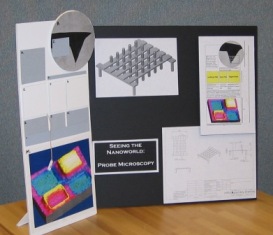 |
Exhibit Prototype Models |
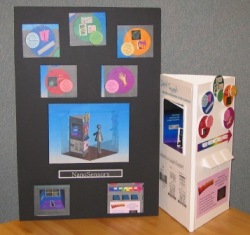 |
| Microscopy | Liquid Crystals | ||
Microscopy Prototype | |
 |
|
| We propose an exhibit highlighting force microscopy intended to complement other exhibits in the proposed nanotechnology exhibit space. As the small size of nanotechnology is a key feature, it would be natural for visitors to have questions regarding the imaging and manipulation of such tiny objects. We propose an exhibit to help answer those questions. | |
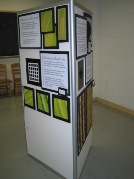 |
Purpose of the exhibit: The exhibit is designed to demonstrate the techniques scientists use to "visualize" nano-scale objects. As these objects are smaller than light wavelengths, light microscopy is unsuitable. Instead of optically imaging these objects, scientists use special instruments to essentially "feel" the patterns of various properties of a given object. Among the properties that scientists can detect are magnetism, electrical properties, and surface texture. Our exhibit gives visitors a chance to use their own senses to feel patterns, much as a force microscopy instrument feels patterns on nano-scale objects. Exhibit activity: The exhibit will have two main interactive features (white areas on model). The first will be a magnetic board - a visually uniform box containing magnets oriented to form a simple geometric pattern. Visitors must use a magnetic wand to trace out the pattern. We anticipate that visitors may need help in guessing the pattern and intend to give them choices with a second interactive feature. This feature would be four silicon pads with evenly spaced bumps throughout. Some bumps will be hollow and soft, while others will the filled and hard; the hard bumps will form more simple geometric patterns, one of which will match the pattern of the magnetic board. Visitors must use their fingertips to trace out the patterns in the silicon pads and match the appropriate pad with the pattern of the magnetic board. If the visitor simply cannot match the patterns, there will be a flip panel revealing the correct answer. |
The exhibit will also incorporate images of force microscopy instruments(large, circular image at top right of model), as well as the images these instruments generate(blue areas on model and lower portion of panel). The text of the exhibit will describe how force microscopy works, how the activity relates to force microscopy, and will detail the different types of force microscopy and how they are used. |
|
Liquid Crystal Prototype | |
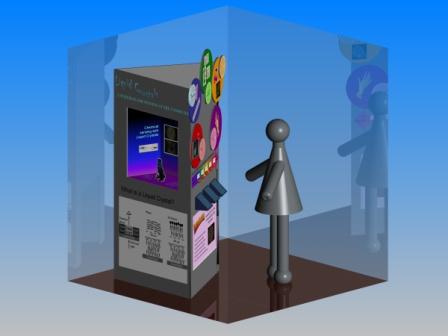
| |
| We propose an exhibit highlighting liquid crystals intended to complement other exhibits in the proposed nanotechnology exhibit space. The small size of nanotechnology allows for high-sensitivity sensing technologies. Liquid crystals are one of many such nanoscale materials that can be used for sensing. Liquid crystals are already found in many commercial products, however their potential for nanosensing is not widely known. We propose an exhibit to teach what liquid crystals are and how they can function as sensors. | |
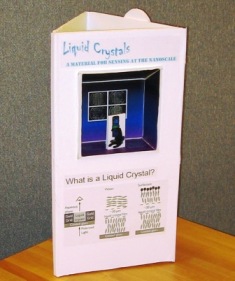 |
Purpose of the exhibit: Liquid crystals (LC) can be thought of as a state of matter between a liquid and a solid: the LC has orientation, like a solid, but also has freedom of movement, like a liquid. LC are sensitive to many stimuli, including heat, chemicals and electric fields. When one LC changes its orientation in response to a stimulus, it causes the other LC around it to change orientation as well, creating a cascading effect. In this way, LC sensors amplify the effect of very small amounts of stimuli. |
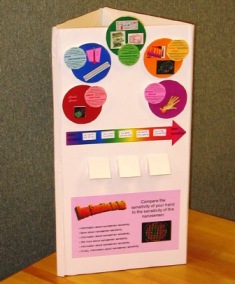 |
Exhibit activity: The exhibit will have several interactive features. The visitor will be able to control a LC sensor and watch the sensor change colors in real-time. The concept of sensitivity will be taught with panels of differing temperatures; the visitor will place their hand on each to see if their own "body sensor" can detect the slight changes in temperature and then compare it to the sensitivity of a thermometer. Visitors can test their knowledge of sensitivity by matching the appropriate sensor with the sensitivity range by pushing buttons that cause the matching application to light up. |
 |
 |
| Visitors can manipulate a LC sensor and watch the change in addition to watching a video of a different type of LC sensor. | The concept of sensitivity is explored through an interactive. |
| The upper panel compares
different types of heat sensors to the liquid crystal nanosensor. The basis for comparison is the degree of sensitivity. The different applications used for comparison are: |
||
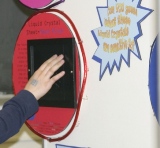 |
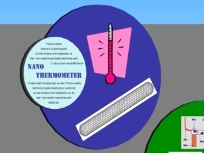 |
 |
| LC sheet and Mood Rings | Thermometers and Nanothermometers | Household thermostat |
 |
 |
|
| Human hand | Night Vision (Infrared) Goggles | |